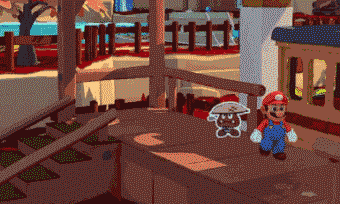 A Super Mario variety blog.
Screenshots, photos, sprites, gifs, scans and more from all around the world of Super Mario Bros.
A Super Mario variety blog.
Screenshots, photos, sprites, gifs, scans and more from all around the world of Super Mario Bros.



- Links
Top: screenshots of the earliest iteration of Project Dream, the Rareware game that would eventually become Banjo-Kazooie after many changes to the concept, design and gameplay. This version was originally an action RPG for the SNES using pre-rendered graphics; this was then changed to an action RPG for the Nintendo 64 with the same human protagonist, and finally to a platformer with Banjo and Kazooie as the protagonists.
Bottom: after that version was abandoned, some of its graphical assets were reused in a heavily modified form in Donkey Kong Country 3 so as to not waste the work that went into creating pre-rendered environments before moving on to the Nintendo 64 which would require completely different real-time graphics.
Note similar mushroom models in the left column and similar pillar models in the right column, in addition to the environments being similar in general.
Main Blog | Patreon | Twitter | Bluesky | Small Findings | Source
In Paper Mario games, even though the characters appear to be 2D sprites, they are actually 3D models internally, simply made to look 2D through applying a variety of effects. For example, even though the model has a regular facing angle internally, this is simplified to only four different sets of graphics being used (facing towards/away from the camera to the left/right), creating the impression of there only being four directions.
It is possible to simply replace the Paper Mario model with a regular 3D Mario model (shown here in Paper Mario: The Origami King, but working similarly in other Paper Mario games) without needing to modify the engine, which showcases the unused 360° facing angles.
In addition, it also demonstrates that whenever Mario turns away from the screen, his model turns inside-out as a consequence of how Paper Mario has two “sides” (front and back) and only one is visible at a time, which is done by turning him inside-out in the same manner.
Main Blog | Patreon | Twitter | Bluesky | Small Findings | Source: HunterXuman
Unused animations of Mario found in development files for Super Mario 64, each referring to a “log” (logwalkL, logwalkR, logwaverL and logwaverR).
While large logs that roll around, which Mario could slip off, appear in the finished game, none of these animations are used for them. The walking animations also suggest that the intent was for Mario to be walking in a tightrope-like manner, so it is possible that the log for which these were originally designed was much narrower.
Main Blog | Patreon | Twitter | Bluesky | Small Findings | Source
By backtracking within the Hot Head Hop level in Donkey Kong Country 2, it is possible to bring Squitter into the bonus room that is accessed via the cannon.
Doing so activates a bizarre glitch whereby after returning to the main level, the screen will automatically scroll at an immense speed to the right, pulling the player characters along with it and killing them shortly afterwards by making them collide with a wall.
Main Blog | Patreon | Twitter | Bluesky | Small Findings | Source: TheStaticCling
In Paper Mario: The Thousand-Year Door, some enemies like Magikoopas and Wizzerds are able to create copies of themselves that look identical to the originals. The usual way to find out which one is the original is to attack all enemies with an area attack, which will disperse the copies.
However, there is an obscure alternate way to find out which one is the original: Goombella is somehow magically able to sense the difference when using her Tattle ability.
Left: tattling a copy of a Magikoopa.
Right: tattling the original Magikoopa.
While this might seem useless due to any normal attack also dispersing the copy and providing essentially the same information, there is one difference: attacking a copy counts as failing the attack and gains no Star Power, while Tattling a copy is a successful attack that does gain Star Power. This can make the option to Tattle the enemies marginally more useful in certain circumstances.
Main Blog | Patreon | Twitter | Bluesky | Small Findings | Source: Thor-Rog
A well-known unused object found in the files of Super Mario 64 is the Yellow Switch. The footage above shows its functionality once it is restored into the game.
Just like the Wing Cap, Metal Cap and Vanish Cap Switches, the Yellow Switch turns blocks of a certain color from translucent and non-interactive into solid and interactive. However, the Yellow Switch’s function is to grant interactivity to regular ! Blocks, which are already solid to begin with in the finished game.
Interestingly, the functionality is broken by default in the finished game, so that regular ! Blocks do not respond to it without being modified. It uses entry number 4 in the list of unlockable blocks, which is only three entries long.
Remarkably, entry 4 on the list of all possible ! Block contents (which starts off the same as the unlockable list, but continues with yellow ! Block contents, and is stored elsewhere in the data) is rideable Koopa Shells, so it is theorized that this was what was originally intended to be unlocked with that switch.
Main Blog | Patreon | Twitter | Bluesky | Small Findings | Source: moonsidefan
In Super Mario Maker 2, if a Yoshi is positioned on a Note Block above rising lava in the manner depicted in the footage, a glitch will occur whereby he will shoot up high into the air and then glide down very slowly upon contact with the lava.
Main Blog | Patreon | Twitter | Bluesky | Small Findings | Source: liamthenintendoguy






















